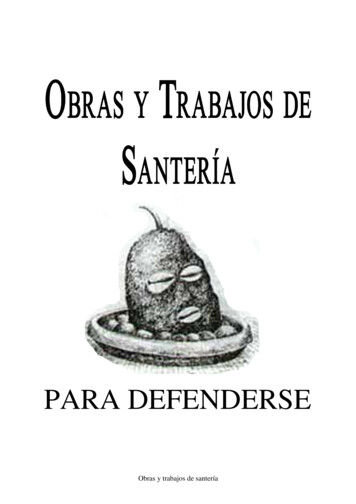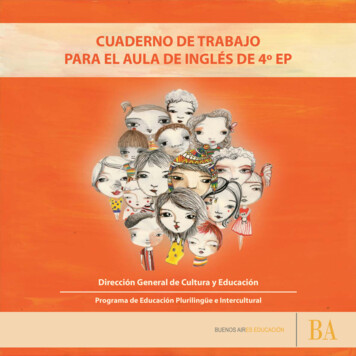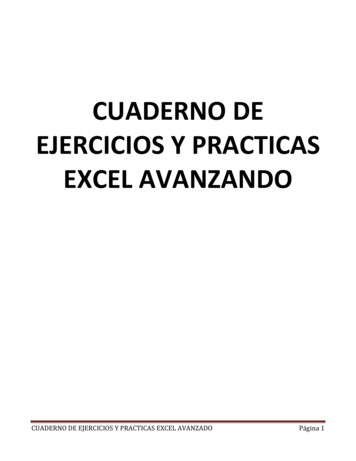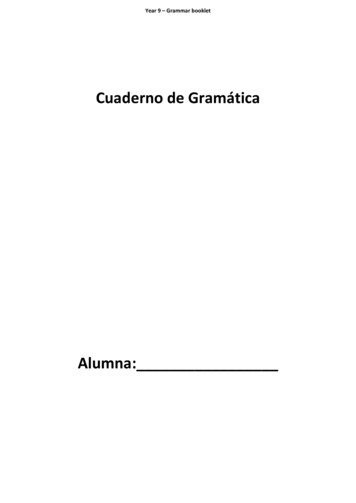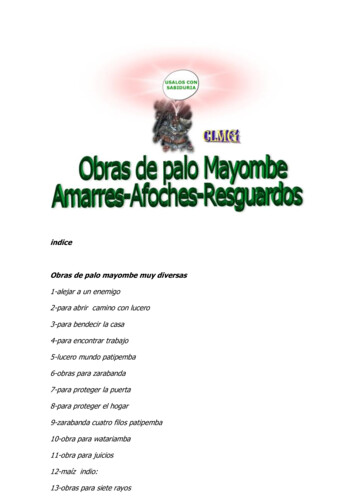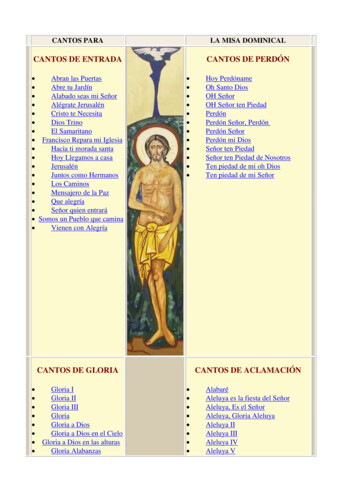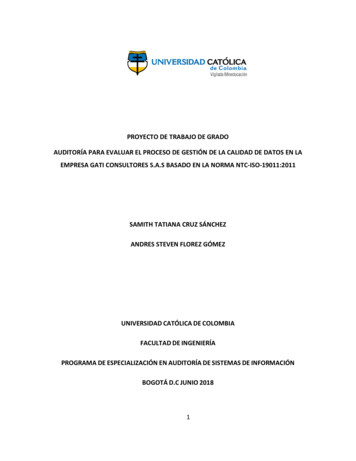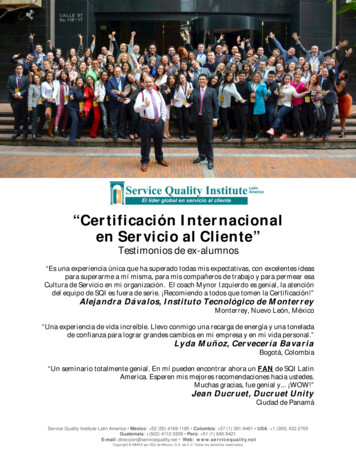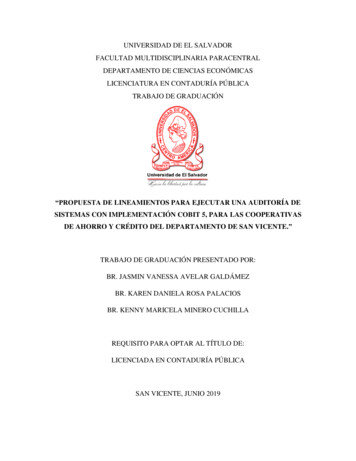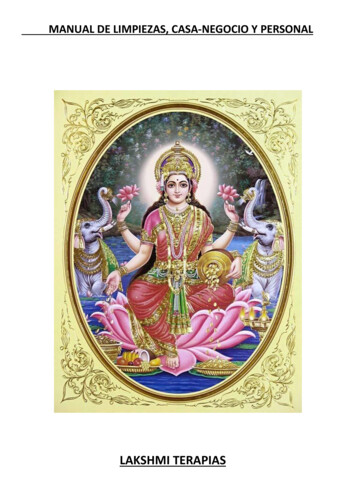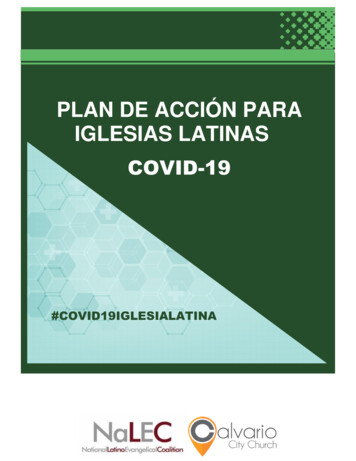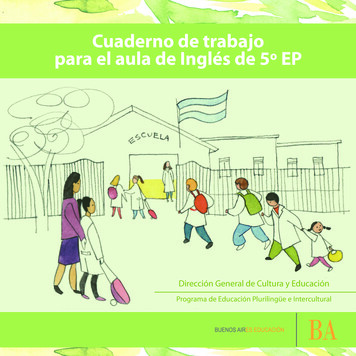
Transcription
Cuaderno de trabajopara el aula de Inglés de 5º EPDirección General de Cultura y EducaciónPrograma de Educación Plurilingüe e Intercultural
Provincia de Buenos AiresGobernadorDn. Daniel ScioliVicegobernadorLic. Gabriel MariottoDirectora General de Cultura y EducaciónPresidenta del Consejo General de Cultura y EducaciónDra. Nora De LuciaVicepresidenta 2ª del Consejo General de Cultura y EducaciónProf. Jorgelina FittipaldiSubsecretario de EducaciónIng. Carlos GianellaCoordinadora del Programa de Educación Plurilingüe e InterculturalMg. Silvana BarboniDirectora Provincial de Educación PrimariaProf. Laura RodríguezDirector Provincial de Proyectos EspecialesCdor. Fernando SpinosoDirector de Contenidos EducativosProf. Fernando Arce
PresentaciónEste cuadernillo de trabajo, destinado al aula de inglés de 5º año de la Escuela Primaria, fue pensado desde una perspectiva plurilingüe e intercultural. Nuestro objetivo central es dar cuenta de la riquezade experiencias previas que traen los niños a la escuela, y propiciar actitudes positivas hacia las lenguas yquienes las usan.El material presenta una estructura de cuento que alienta a múltiples identificaciones con los diversos personajes y acciones que tienen lugar en la trama de la historia. La lengua se presenta en situaciones de prácticas de translenguaje; es decir, a lo largo del material se muestran usos flexibles y fluidos de másde una lengua para crear e interpretar significados más acabados, ante una diversidad de interlocutoresplurilingües y con propósitos varios. Es por ello que los diálogos presentan instancias de usos del español yde lenguas originarias, como parte del entramado de lenguas disponibles en la provincia de Buenos Aires.Esto no es un hecho menor, en tanto reconoce el carácter plurilingüe de la realidad bonaerense como partede la riqueza y la diversidad cultural que caracterizan a nuestra provincia. En tal sentido, confiamos en quela propuesta de trabajo que presenta el material permita iniciar, desde muy temprana edad, el desarrollode una conciencia intercultural; es decir, la capacidad de experimentar la otredad de modo constructivo yrespetuoso.Las actividades propuestas dan cuenta de un enfoque de resolución de problemas, coherente conla normativa curricular provincial. Asimismo, atienden a garantizar condiciones áulicas que propicien unclima de trabajo favorable para que los niños se animen a experimentar con la lengua; ensayar maneras dedecir y hacer sobre temas de su interés en nuestro contexto.Por otra parte, se intenta apoyar el trabajo de nuestros docentes con un material flexible a las necesidades contextuales. El cuadernillo podrá usarse como recurso editorial principal para el trabajo del aulaen una determinada parte del ciclo lectivo; como material complementario a los recursos disponibles enla escuela; o como sustento para el desarrollo de un proyecto sobre prevención del bullying desde la clasede inglés. Asimismo, cada docente podrá dar vuelo a su creatividad ofreciendo otras actividades no contempladas aquí. Reconocemos así su autoridad para determinar la forma en que este material será usado,adaptándolo a las necesidades áulicas e institucionales de cada escuela.Mg Silvana BarboniCoordinadoraPrograma de Educación Plurilingüe e Intercultural
ContentsUnit 1 .Unit 2 .Unit 3 .Unit 4 .Unit 5 .Projects bank .Dirección General de Cultura y EducaciónCuaderno de trabajo para el aula de 5 año de inglés de educación primaria /coordinado por Barboni Silvana. - 1a ed. - La Plata : Dir. General de Cultura y Educaciónde la Provincia de Buenos Aires, 2013.30 p. ; 29x21 cm.ISBN 978-987-676-061-41. Enseñanza de Inglés. I. Silvana, Barboni, coord. I. Título.CDD 372.65Textos: Mg. Silvana BarboniDiseño y Diagramación: DGP Adriana MurúaIlustración: Prof. Ana Lavarello 2013, Dirección General de Cultura y EducaciónProvincia de Buenos AiresISBN 978-987-676-061-4Hecho el depósito que marca la Ley N 11.723.Impreso en Argentina.Ejemplar de distribución gratuita. Prohibida su venta.3915192328
Unit 1Unit 1: New at schoolMiss Pérez: Chicos, hoy recibimos a una nueva compañera en el grado,Chang Hui-Mei, pero le dicen A-Mei.Children: Oh!Miss Pérez: No habla español por eso vamos a tratar de hablarleinglés los primeros días, hasta que vaya poco a poco comprendiendoy hablando español. Espero que me ayuden. OK? This is A-Mei, children,say hello!Children: Hello!Miss Pérez: A-Mei comes from Taiwan. She is in our town with herfamily and she is now a student in this school. Welcome to our class, AMei! Please take a seat.Nahuel: Do you want to sit here?A-Mei: Yes, thank you.Programa de Educación Plurilingüe e Intercultural
Unit 1PlacesTaiwan is an island in the Pacific Ocean on the eastcoast of China, in Asia. The capital is Taipei. Taiwanhas got a population of 21 million people. Theyspeak Mandarin Chinese. The island has got highmountains in the centre and lots of forests. Taiwanhas got a tropical climate.TaiwanLocation: Island in the Pacific OceanPopulation: 21 million peopleLanguage: Mandarin ChineseCapital city: TaipeiGeographic features: mountains in the centre- forestsClimate: tropicalWhat about the Province of Buenos Aires?Complete the fact file and then write about ourprovince.Province of Buenos AiresLocation:Population:Language:Capital city:Geographic features:Climate: Dirección General de Cultura y Educación
Unit 1Views of my townWhat do the signs mean? Match.schoolchurchrestauranthospitalhotelpolice stationpost officeWhere do they work?.Programa de Educación Plurilingüe e Intercultural
Unit 1A map of town. Where is it? Read the clues, look at the pictures and write the names.a.The supermarket is opposite the park. It is a yellow shop.b.The bank is on the corner of Belgrano Road and San Martín Avenue. It is a red building.c.The school is between the bookshop and the Town Hall.d.Next to the hotel there is a cinema.e.The baker’s is opposite the hotel.f.The post office is next to the baker’s.g.The church is opposite the park, to the right of the Town Hall.h.The Town Hall is between the school and the church. Dirección General de Cultura y Educación
Unit 1What about your town?Draw a sketch of your town and describe it.Programa de Educación Plurilingüe e Intercultural
Unit 1Where? Picture dictation.Listen and draw the missing information.Where’s the girl with the dog? .Where are the boys playing football? .Where’s the fountain? .Where’s the ice-cream stand? .Where’s the big tree? .Game: In pairs guess what part of the picture your friend is describing. Listen to the position of theobject/person. Use “It” for objects and “This person” for people. Dirección General de Cultura y Educación
Unit 2Unit 2: A-Mei in our schoolStefi: A biscuit? Do you want a biscuit?A-Mei: Yes, thanks!Lucía: Do you like the school?A-Mei: Yes, it’s nice.Stefi: Why are you here?A-Mei: Because I’ve got uncles and aunts in Argentina. We want all the familytogether.Lucía: Oh! I only meet my cousins for Christmas every year. They live in Spain. Theycome and stay with grandma for Christmas. We play games and listen to musictogether. I wish they were here Stefi: Do your parents work in the supermarket opposite the park?A-Mei: Yes, that is our supermarket.Programa de Educación Plurilingüe e Intercultural
Unit 2Stefi’s cousinsWhere do these words go?I’ve got cousins,their names are José, Juan and Manuel.We live next door on Belgrano .It’s fun to have them close.We walk to together,We play together all day long.We do taekwondo, skate,ride our bikes and card games.It’s great to have cousinslike José, Juan and Manuel.10Dirección General de Cultura y EducaciónthreeplayschoolRoadroller
Unit 2Listen to the children. What do they do at weekends with their cousins?How many cousins?What activities?PedroLucíaA-MeiDanielNahuelWhat about you?.On a picnic with my friendsSofía: Let’s have a picnic on Saturday!Lucía: Yes!Nahuel: Do you want to come?A-Mei: Yes, I’d love to.Sofía: I can take some biscuits.Nahuel: I can take some crisps, then.Programa de Educación Plurilingüe e Intercultural11
Unit 2At grandma’s1.2.3.4.5.6.Every weekend I stay at grandma’s with my sister and cousin Joel.We listen to grandma’s stories.We sleep in the living room.The next day we wake up late and have chocolate for breakfast.We help Grandma feed the hens.We cook tortas fritas for tea.Order the pictures12Dirección General de Cultura y Educación
Unit 2What about you? What do you do at weekends? Put a tick or a cross. Then ask your partner.Do you YOUYOUR PARTNERstay at your grandparents’ home?cook with your grandmother?ride a bike?help someone in your family?roller skate?Write about you. Use your answers. Then draw.Programa de Educación Plurilingüe e Intercultural13
Unit 2Grandpa the vegan cookGrandpa’s the cookof a vegan bistró.Here’s what he saysall day long:“Eat your vegetables,Clean your plate!Eat your vegetables,veggies are great!Green beans, broccoli,lettuce and peas,carrots and tomatoes,more corn please!Spinach and potatoes,peppers and onions.They’re good for you!Eat your vegetables,veggies are great!”(adapted from Goldfish, 1996)About you:What’s your favourite family dish?Who cooks it in your family?When do you eat it?What ingredients has it got?14Dirección General de Cultura y Educación
Unit 3Unit 3: The bulliesNahuel and Pedro are in the park after schoolA-Mei is going home alone.Two boys approach her.Nahuel and Pedro help A-Mei.What do you think?What do the bullies sayto A-Mei?Programa de Educación Plurilingüe e Intercultural15
Unit 3We are all beautiful in our diversityRead the descriptions and match them with the pictures. Then complete the missing description.Nahuel She’s got long brown hair and a big nose. Her eyesare brown and her ears are big. He’s got short fair hair and green eyes. His nose issmall and his ears are big.A-MeiStefi He’s got short brown hair and big brown eyes. Hisnose is small and his mouth is small. He’s got black hair and black eyes. His face is roundand his nose and mouth are medium. She’s got beautiful black eyes and black hair. Herears are small and her nose is small.DanielPedroLucía16Dirección General de Cultura y Educación
Unit 3Different is beautifulListen to these descriptions. Match.Maríashortfair hairJuantalllong brown hairTotoslimshort black hairMailénplumpshort red hairSandrathinlong black hairWrite the names of the children under the pictures.What about you? In what ways are youbeautiful and unique?Describe yourself.Programa de Educación Plurilingüe e Intercultural17
Unit 3In.In.the.city,a street.In the streeta block of flatsemptybut for one flat.In that flat,one roomlit up.In that roomone person.In that persona heart:CaboomCaboomCaboom.(adapted from In by Michael Rosen)Imagine your own poem.18Dirección General de Cultura y Educación
Unit 4Unit 4: The bullies strike againNahuel: Pedro! Come here! Do you want to play hide and seek?Pedro: No.A-Mei: What’s the matter? Are you OK?Pedro: Not really.Nahuel: Why are you sad?Pedro: They are calling me names. The problem is that I like school.Daniel: What?Pedro: They are calling me “Nerd”.Nahuel: Who?Pedro: Those boys from 6th.A-Mei: We must tell the teacher!Programa de Educación Plurilingüe e Intercultural19
Unit 4FeelingsSadHappyAngrySurprisedExcitedI like school, that is not a problem!Complete the timetable with what the children say.I like school. My favourite subject is English. I’ve got English on Monday at ten o’clock. I don’t like Mathsvery much.My favourite subject is Science. I love animals and plants. We’ve got Science on Tuesday at 8 o’clock.I love Physical Education. We play football and volleyball in P.E. I love Wednesday because we’ve got P.E.Thursdays is a funny day because we’ve got Music at 11 o’clock. I love singing and our teacher is very nice.On Fridays we’ve got Art. n General de Cultura y EducaciónScience
Unit 4Different children, different schools.I go to Sabbath School on Sunday. My teacher iscalled Hannah and she reads stories from the Bibleto me and my classmates. We listen to the storiesand talk about them. Some of the stories are reallynice.In our Martial Arts school we learn to have disciplineand respect for ourselves and other people. We donot learn to fight. We learn about peace. I spendtwo hours a week in the school. I do taekwondobut there are other activities, for example, judo.I go to the Braille school twice a week. Some ofmy teachers are blind, too. They teach me to readBraille handwriting. I read the alphabet and thenumbers with my fingers. I also use my computerto listen to texts. The school helps me and myparents a lot.In my community there is a language nest. Allthe children from the community can learnthe language of our grandparents there. In mylanguage nest I learn Mapuche. We listen to stories,cook our traditional dishes and play our traditionalgames in Mapuche. It is great to learn about yourtraditions.Do you go to any of these schools? Do you go to any other school? What do you do there?Programa de Educación Plurilingüe e Intercultural21
Unit 4Listen to the children talking about their schools. What is special about them? Listen and complete:1. In this school children do . early in the morning.2. In this school children . during a test.3. In this school children have classes in the . .4. In this school children speak . different languages.The best school in the world.What education is good for children? What do you think? What activities do children do there? Completethe poster for the best school in the world using your ideas.The best educationThe best future In this school children: ******* Better education for a better world22Dirección General de Cultura y Educación
Unit 5Unit 5: What are you doing?Teacher: What are you doing?Bullies: Nothing.Teacher: Nothing? Is this nothing? Are you OK, Stefi?Stefi: It hurts!Teacher: I know! I’m sorry!Bullies: Sorry!Teacher: You two. Come with me now!Programa de Educación Plurilingüe e Intercultural23
Unit 5Help stop bullying NOW!24Dirección General de Cultura y Educación
Unit 5What type of bullying is Billy suffering?Billy Doesn’t Like School ReallyBilly doesn’t like school really.It’s not because he can’t do the workbut because some of the other kidsdon’t seem to like him that much.They call him namesand make up jokes about his mother.Everyone laughs. except Billy.Everyone laughs. except Billy.They all think it’s OKbecause it’s only a laugh and a jokeand they don’t really mean it anywaybut Billy doesn’t know that.Billy doesn’t know thatand because of thatBilly doesn’t like school really.Paul Cookson (2007)Programa de Educación Plurilingüe e Intercultural25
Unit 5Types of bullyingTypes of bullyingTypes of bullyingVerbal Bullying :Indirect BullyingTechnological Bullying Name calling, not justcalling you names butcalling your loved onenames. Ignoring someone,leaving them out or notallowing them to join ina game. Threatening you, bysaying an older brotheror sister is going to hurtyou, or they are waitingfor you after school. Spreading rumours,talking about youbehind your back andsaying things that arenot true.Using internet to showpictures, embarrassothers, set up groupsand encourage othersto take part in bullyingonline. Chat rooms, using chatrooms to spread gossipand hurt people’sfeelings‘The bad eyes’, someoneglaring or giving youthreatening looks. Abusive text messages. Happy slapping, this iswhen you use a phoneor a video camera andfilm someone beingslapped or attackedunknowingly. Silent or abusive phonecallsPhysical Bullying Hitting, kicking, biting,scratching, pushing,tripping you up onpurpose. Haveyou eversufferedany form ofbullying?(adapted from ://www.bullybusters.org.uk/kids/what is bullying)26Dirección General de Cultura y Educación
Unit 5Report bullying to stop it. Tell your teacher.If someone is bullying you. Don’t suffer in silence. Tell an adult about it. Don’t hit back or ignore it.If you see someone bullying another person. Tell an adult the 4 W (WHAT happened, WHEN, WHERE and to WHO). Ask the bullied person if he/she is OK.Programa de Educación Plurilingüe e Intercultural27
Projects bankProject 1:Making schools better for a better world. Develop a diversity friendly atmosphere in your school. Do allchildren feel represented? Draw posters with poems, rhymes, photos, pictures and any other text that showswe are all unique and beautiful. Show different activities children do in their lives. Post your productionsaround the school. Make sure all children in your school can feel represented in the pictures and the texts.This is not enough to make your school a diversity friendly place, but it is the first step.Project 2:Develop an anti bullying campaign at school. Make posters for your school walls with information aboutbullying and bullying prevention. Design leaflets with information on bullying. Go to other courses in groupsand with your teacher tell the children in other courses about bullying and distribute the leaflets. You canuse as many different languages as is necessary for other children to understand.Project 3:Library search for thought-provoking-drama. Go to the library with your teacher and ask the librarian forbooks with stories on the importance of diversity in our world. They can be stories in different languages.Develop a reading out loud session in the library. Choose the stories you like best and with your teachers,both the English and Spanish teachers, transform them into short plays. Act them out in your school fordifferent courses in different languages.Project 4:A literary café for parents. Take up the poems in this book. Ask your teacher to bring some more poems.Rehearse them until you know them by heart. Develop a literary café in English for your parents. Prepareto recite the poems in front of your parents, you can use posters, costumes, real objects, etc. You canalso include poems in Spanish or any other language present in your school community to turn it into aplurilingual literary café. If you want you can invite your Music teacher and you can also include songs indifferent languages.28Dirección General de Cultura y Educación
Bibliography Cookson, P. (2007) “Billy doesn’t like school really”. En British Council. Made to Measure Argentina. BuenosAires: British Council Voices. Goldfish, M. (1996). 101 Poems and Songs for Young Learners. New York: Scholastic. Rose, M. (1974). “In.” En Rosen, M. Even my Ears are Smiling. Londres: Bloomsbury.Sites Bully busters: http://www.bullybusters.org.uk/kids/what is bullying/ [último acceso 28 de mayo de2013]Este material se terminó deimprimir en la ciudad de La Plata,en el mes de abril de 2013.
Cuaderno de trabajo para el aula de 5 año de inglés de educación primaria / coordinado por Barboni Silvana. - 1a ed. - La Plata : Dir. General de Cultura y Educación de
